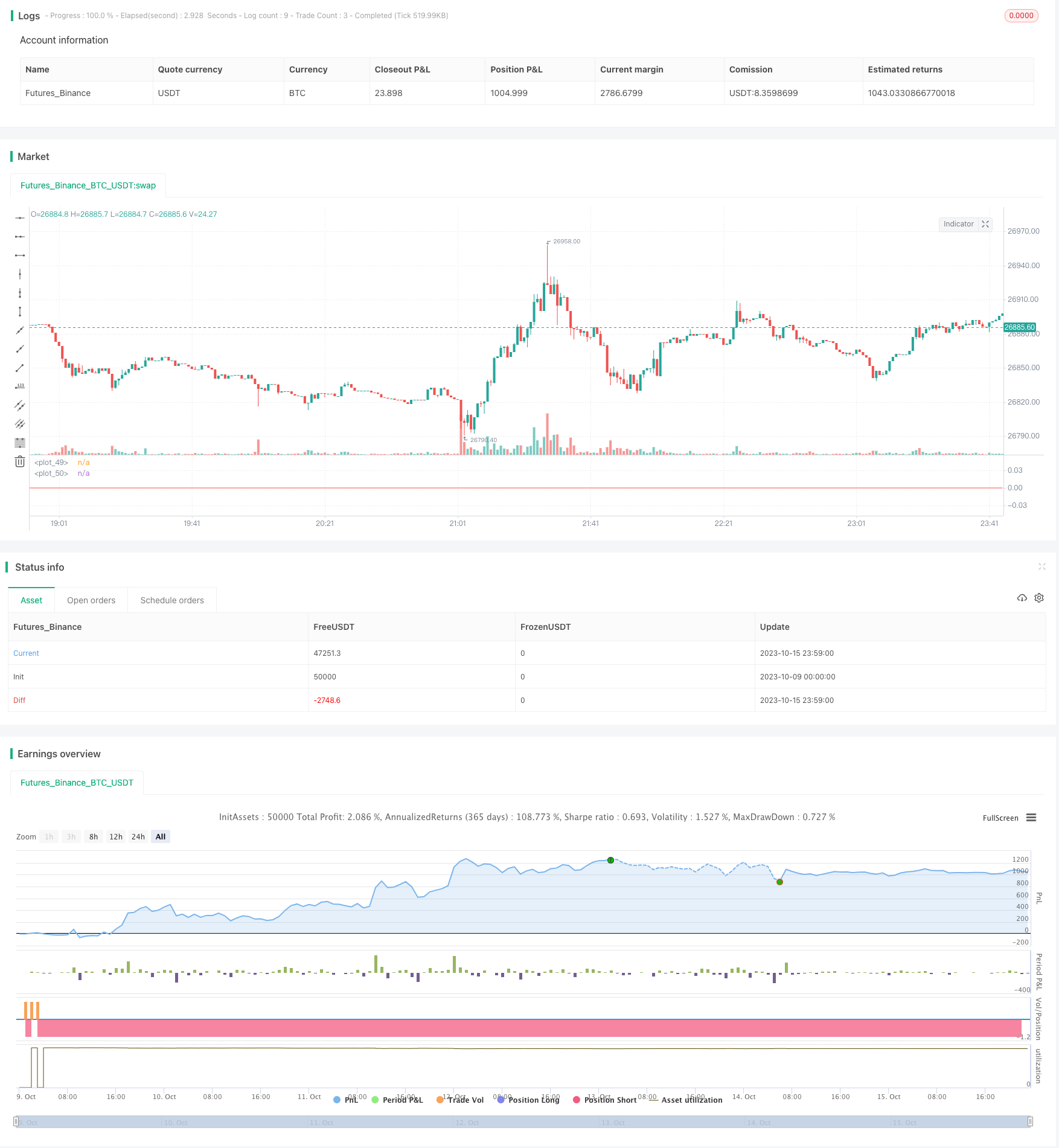
概述
该策略利用两条不同长度的指数移动平均线(EMA)的斜率交叉来生成趋势跟踪信号。默认使用长度为130和400的EMA,这两个参数的组合效果很好。
当快线EMA斜率上穿慢线EMA斜率且价格高于200周期的EMA时做多;当快线EMA斜率下穿慢线EMA斜率且价格低于200周期的EMA时做空。
斜率方向相反交叉时平仓。
该策略在比特币和流动性强、市值大的Altcoin上表现最佳,但在波动性较大的资产上也运作良好,尤其是这些资产经常出现趋势行情时。
最适合4小时时间框架。
还配套了一个可选的波动率过滤器,仅当两条斜率之间的差值大于特定阈值时才开仓,目的是避免价格横盘震荡时噪音远大于信号时打开仓位。
效果惊人,请享用!
策略原理
该策略的核心是比较两条不同长度EMA指数移动平均线的斜率。
首先计算长度为130和400的EMA,然后计算各自的斜率,再对各自的斜率计算长度为3的EMA得到平滑后的斜率曲线。
当快线EMA斜率上穿慢线EMA斜率时产生买入信号;当快线EMA斜率下穿慢线EMA斜率时产生卖出信号。
为过滤震荡,可以选配200周期的EMA作为趋势过滤器,仅在价格高于该EMA时考虑做多信号,低于时考虑做空信号。
此外,还可以选配一个波动率过滤器,仅当两条斜率之间的差值大于预设阈值时才产生信号,从而过滤掉斜率交叉但波动率不足的情况。
当快慢斜率反向交叉时,平掉仓位停止盈亏。
优势分析
使用斜率交叉产生信号,可以有效跟踪趋势
调整EMA周期参数组合,可以适应不同的市场环境
趋势过滤器能避免被震荡行情误导
波动率过滤器可过滤假信号
规则简单清晰,容易理解实现
可在多个时间框架上使用
风险分析
大幅震荡行情中可能出现频繁 Open 和 Close
EMA周期参数不当可能错过趋势转折点
须适当调整参数组合以适应市场环境变化
与 MA 系统类似,大趋势末尾可能反转损失
优化方向
尝试不同的 EMA 周期组合参数,寻找最佳参数
根据不同币种特性和市场环境选择参数
可以考虑加入止损策略控制风险
可以考虑动态调整 EMA 周期参数
尝试不同的波动率阈值参数
测试在不同时间框架上的效果
总结
该策略整体思路清晰易懂,利用 EMA 斜率交叉产生信号,可有效跟踪趋势;配套趋势过滤器和波动率过滤器可减少噪音交易。通过调整 EMA 周期参数组合可适应不同市场环境。总体来说是一种简单实用的趋势跟踪策略,值得在实盘中测试优化。
/*backtest
start: 2023-10-09 00:00:00
end: 2023-10-16 00:00:00
period: 1m
basePeriod: 1m
exchanges: [{"eid":"Futures_Binance","currency":"BTC_USDT"}]
*/
//@version=4
// strategy(title="Slopes",initial_capital=1000, default_qty_type=strategy.percent_of_equity, commission_type=strategy.commission.percent, commission_value=0.06, slippage = 2, default_qty_value=30, overlay=false)
//definizione input
start = timestamp(input(2018, "start year"), input(1, "start month"), input(1, "start day"), 00, 00)
end = timestamp(input(2020, "end year"), input(1, "end month"), input(1, "end day"), 00, 00)
average = input (title="Source MA Type", type=input.string, defval="EMA",options=["EMA","SMA"])
len1=input(130,title="Fast MA Length")
len2=input(400,title="Slow MA Length")
smoothingavg = input (title="Smoothing MAs Type", type=input.string, defval="EMA",options=["EMA","SMA"])
smoothingavglen = input (3,title="Smoothing MAs Length")
trendfilter=input(true,title="Trend Filter")
trendfilterperiod=input(200,title="Trend Filter MA Period")
trendfiltertype=input (title="Trend Filter MA Type", type=input.string, defval="EMA",options=["EMA","SMA"])
volatilityfilter=input(false,title="Volatility Filter")
volatilitydelta=input(0.0003,step=0.0001,title="Delta Slopes EMA")
//variabili
m1 = if average == "EMA"
ema(close,len1)
else
sma(close,len1)
m2=if average == "EMA"
ema(close,len2)
else
sma(close,len2)
slp1=(m1-m1[1])/m1
slp2=(m2-m2[1])/m2
e1=if smoothingavg == "EMA"
ema(slp1,smoothingavglen)
else
sma(slp1,smoothingavglen)
e2=if smoothingavg == "EMA"
ema(slp2,smoothingavglen)
else
sma(slp2,smoothingavglen)
plot(e1,color=color.yellow)
plot(e2,color=color.red)
//plot (abs(e1-e2),color=color.white)
//plot (ema(e1-e2,9),color=color.yellow)
//variabili accessorie e condizioni
TrendConditionL=if trendfiltertype =="EMA"
close>ema(close,trendfilterperiod)
else
close>sma(close,trendfilterperiod)
TrendConditionS=if trendfiltertype =="EMA"
close<ema(close,trendfilterperiod)
else
close<sma(close,trendfilterperiod)
VolatilityCondition = abs(e1-e2) > volatilitydelta
ConditionEntryL= if trendfilter == true
if volatilityfilter == true
e1>e2 and TrendConditionL and VolatilityCondition
else
e1>e2 and TrendConditionL
else
if volatilityfilter == true
e1>e2 and VolatilityCondition
else
e1>e2
ConditionEntryS= if trendfilter == true
if volatilityfilter == true
e1<e2 and TrendConditionS and VolatilityCondition
else
e1<e2 and TrendConditionS
else
if volatilityfilter == true
e1<e2 and VolatilityCondition
else
e1<e2
ConditionExitL=crossunder(e1,e2)
ConditionExitS=crossover(e1,e2)
if true
if ConditionExitS
if strategy.position_size < 0
strategy.close("SLPShort")
if true
if ConditionExitL
if strategy.position_size > 0
strategy.close("SLPLong")
if true
if ConditionEntryL
strategy.entry ("SLPLong",long=true)
if true
if ConditionEntryS
strategy.entry("SLPShort",long=false)